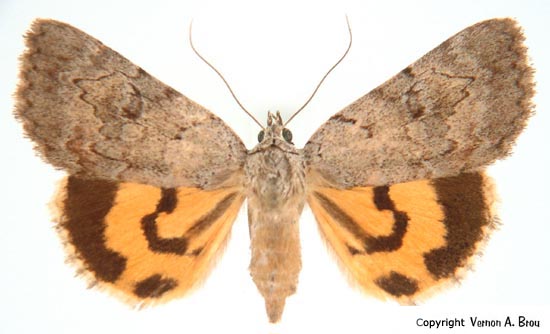Catocala alabamae
Catocala alabamae
kah-TOCK-uh-lahmmal-uh-BAM-ee
Grote, 1875

Catocala alabamae, Louisiana,
courtesy of Vernon A. Brou.
This site has been created by
Bill Oehlke at oehlkew@islandtelecom.com
Comments, suggestions and/or additional information are welcomed by Bill.
| TAXONOMY:
Superfamily: Noctuoidea
Family: Noctuidae
Group: Noctuinina
Subfamily: Catocalinae
Genus: Catocala, Schrank, 1802
| |
MIDI MUSIC
"Moon River"
copyright C. Odenkirk
MIDI CITYON.OFF
<bgsound src="moon.mid" LOOP=FOREVER>
|
DISTRIBUTION:
Catocala alabamae, the Alabama
underwing, (wingspan: 30-40mm) flies from Maryland south to Florida,
west to Texas and north to Missouri and Illinois.
Titania (wingspan: 20-35mm) has recently been reclassified as
alabamae and seems to have a more northern range with
specimens taken in Pennsylvania. Alabamae has heavier, darker markings on the forewings and hindwings.
See Catocala alabamae for a more complete range.
The uniform greenish-grey forewing may have thin but dark (contrasting) medial lines
or they may be nearly absent (titania); alabamae often
displays a dash in the median/anal angle area, missing or nearly absent in titania.
There is brown shading between the post medial line and the subterminal line.

Titania by Vernon A. Brou.
FLIGHT TIMES AND PREFERRED FOOD PLANTS:
Catocala alabamae are usually on the wing from April-May (Texas) to June,
July and August elsewhere.
The Catocala alabamae caterpillar shows a preference for
hawthorns, wild crabapple and Chickasaw plum.
ECLOSION:
Adults eclose from pupae at soil surface.
SCENTING AND MATING:
Catocala alabamae females
emit an airbourne pheromone and males use their antennae to track the
scent plume.
EGGS, CATERPILLARS, COCOONS, AND PUPAE:
Eggs are deposited on
tree/bush bark in the fall and hatch the following spring.
Larval Food Plants
Listed below are primary food plant(s) and alternate food plants.
It is hoped that this alphabetical listing followed by the common
name of the foodplant will prove useful. The list is not exhaustive,
although some species seem very host specific.
Experimenting with closely related foodplants is worthwhile.
Crataegus
Crataegus calpodendron.....
Malus coronaria
Prunus angustifolia
|
Hawthorn
Red haw/Pear hawthorn/Urn-tree haw
Wild crab apple
Chickasaw plum
|
Return to Main Index

